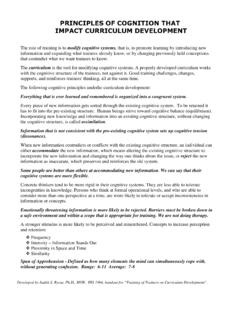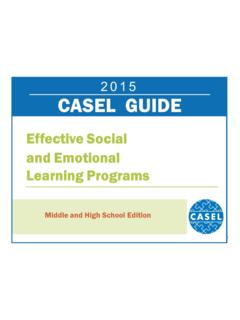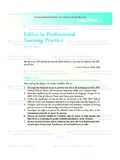Transcription of Transfer of Training and Adult Learning (TOTAL)
1 Transfer of Training and Adult Learning ( total ) Dale H. Curry, Patty Caplan, and Jane Knuppel Northeast Ohio Regional Training Center Social work Training frequently fails to enhance job performance because it is not viewed as a collaborative process involving factors that affect the social worker before, during, and after Training . This article explores the variables that affect Transfer of knowledge and introduces a model to assess and intervene in the Learning and Transfer process. By assessing the forces that promote or inhibit Transfer , social work trainers can provide direction for Transfer intervention and help transform Training into effective social work performance. Transfer of Training and Adult Learning refers to the application of Learning , knowledge, skills, and attitudes acquired in a Training setting to the job.
2 Seldom do providers of social work Training evaluate the amount of knowledge transferred through Training . There seems to be an implicit assumption that Training : is valuable, yet evaluations of Training rarely go beyond the typical reaction/satisfaction" questions that participants complete at the end of Training sessions. Although the human service sector has not emphasized Transfer , much has been learned from Training in the private sector and from the fields of educational psychology, organizational psychology, and instructional design. This article integrates information from the aforementioned fields with our child welfare Training and evaluation experiences at the Northeast Ohio Regional Training Center and Summit County Children Services Board. It explores the variables that affect the Transfer of Learning to child welfare social workers and introduces readers to a basic, yet comprehensive model of Transfer assessment and intervention.
3 Factors That Affect Transfer Application of social work Training in child welfare agency settings involves numerous factors. By identifying key Transfer elements, however, social workers can devise Training interventions that can have a positive impact on complex and often confusing child welfare situations. Baldwin et al. (1988) found three major Transfer components: trainee characteristics, Training design, and the trainee environment. Individual trainee characteristics include skill and motivation level, ability to learn and apply knowledge, Learning styles, personality factors (attitudes and values), level of education, age, life experiences, degree of burnout, and Training expectations. A Transfer -oriented Training design must consider both these characteristics and the trainee environment. The trainee's environment includes the degree of support or interference the supervisor shows toward Learning , coworkers, technology, Training , personnel, and administrators.
4 The organization's leaders and the behavior they exhibit can influence what knowledge is transferred, and what stays in the classroom. The value placed on Training by the organization conveys strong messages about how seriously employees view Training , and whether knowledge Transfer is enhanced or impeded. The importance of Training is communicated in many ways, such as the physical location of the Training department and who is hired as the Training director. Time is another important Transfer element. Due to time constraints, the priority level given to Training and Transfer efforts often is lower than direct client service delivery efforts, or other mandated activities with strict timelines. For example, when court summaries are due by the end of the workday, it is difficult to maintain worker attention during Training .
5 The opportunities workers have to apply newly learned skills represent another critical factor affected by time. Unless workers can use new skills in a timely manner, Learning often is lost. Time elements, therefore, must be a prime consideration in designing Training . An assessment of an organization's environmental factors can be enhanced by examining the agency's goals, roles, rules and interpersonal expectations. Individual, team, department, and agency goals influence the relevance and value given to Training and knowledge application. Clarifying these goals, as well as the organization's overall goals, can lay the foundation and provide direction for Transfer interventions. Conversely, Transfer failure often can be traced to a lack of clarity in the organization and its subdivisions' Training goals, roles, and rules.
6 Transfer can be promoted or impeded by assigning individual roles within the organization to handle specific Training and Transfer responsibilities. Placing supervisors or coworkers in the role of Transfer coach" can underscore the importance of applying Learning in the workplace. Once Training goals are established, Transfer potential can be enhanced by clarifying these roles. Formal and informal agency rules regarding Training and Transfer also help to clarify and solidify Transfer responsibilities. For example, rules requiring trainees to provide post-workshop reports to teammates or attend "booster shot" Training reviews can help to routinize the application of Learning . When Transfer goals, roles, and rules are clear and understandable, one of the positive side effects can be the promotion of interpersonal behavior to encourage active participation in the Learning and Transfer process.
7 When participants feel mutual respect and trust, they will be more likely to take appropriate risks to enhance their self-awareness, motivation, and skill development in the classroom and at work. The child welfare social worker's "work space" extends beyond the agency setting to client homes and neighborhoods, and to juvenile and domestic courts, school systems, and other agency settings. Each of these systems maintains its own set of goals, roles, rules, and expectations of interpersonal behavior. The Training design must consider interventions that can be effective in these multiple environments. Training Design and Needs Assessment The Training design includes factors such as Training content, principles of Learning , and sequencing of Training activities (Baldwin et ). Parker's Training cycle (Ulshak 1983) provides a useful model for viewing the Training design, it consists of the following sequence: conduct needs assessment, develop Training objectives, design curriculum, design/select Training methods, design evaluation approach, conduct Training , and measure results.
8 Transfer considerations need to be integrated into all phases of the cycle. The needs assessment stage must tic Training to social work performance. An important step in the cycle is to identify social worker competencies that lead to successful performance. Several states, including Ohio, Oklahoma, and Pennsylvania, use competency-based needs assessments in their child welfare Training programs. Recently, states have placed much emphasis on identifying, essential competencies for child welfare caseworkers and how competency-based standardized Training is developed (Hughes et al. 1989). Using multiple methods to assess needs can ensure that Training is properly targeted. Agencies routinely collect needs assessment information, such as critical incident reports, state monitoring findings, turnover rates, and exit interviews.
9 However, this information seldom is systematically reviewed for its needs assessment value. These questionnaires and interviews can help to determine essential Training competencies. When Training need is indicated by more than one assessment method, there is a greater chance that Training can have an impact in the workplace. Identifying the barriers and facilitators to Transfer should be a routine process that occurs during the needs assessment stage. A comprehensive approach would assess individual trainee characteristics and the trainee's environment. Examining trainee characteristics, such as skill and motivation levels, can help provide early information to determine when Training can aid in solving a performance problem (Stewart 1986). Social workers who show limited skill, but high motivation to learn a particular competency, are probably appropriate for Training and application: it is easier to teach and reinforce applications if the worker is highly motivated.
10 If motivation is low, however, Training may not be a solution, and other performance solutions may be more effective. Training is more appropriate where there is a skill deficiency, rather than a lack of execution (Mager 1970). Workers who possess both high skill and high motivation levels need to be reinforced for their efforts, too. These workers may be good candidates to facilitate Transfer by coaching less skilled workers. Workers with high competency and low motivation levels may not be performing up to par, possibly due to the presence of performance barriers unrelated to Training . In these cases, self-awareness and stress management Training may be more appropriate. Other needs assessment implications that go beyond the scope of this article may be ascertained through a grid analysis of these two Transfer factors.














